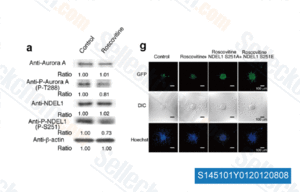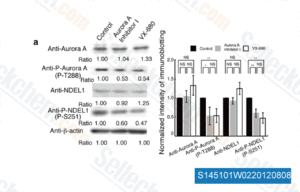|
Toll Free: (877) 796-6397 -- USA and Canada only -- |
Fax: +1-832-582-8590 Orders: +1-832-582-8158 |
Tech Support: +1-832-582-8158 Ext:3 Please provide your Order Number in the email. |
Technical Data
| Formula | C31H31ClFN7O2 |
||||||
| Molecular Weight | 588.07 | CAS No. | 1158838-45-9 | ||||
| Solubility (25°C)* | In vitro | DMSO | 100 mg/mL (170.04 mM) | ||||
| Water | Insoluble | ||||||
| Ethanol | Insoluble | ||||||
| In vivo (Add solvents to the product individually and in order) |
|
||||||
|
* <1 mg/ml means slightly soluble or insoluble. * Please note that Selleck tests the solubility of all compounds in-house, and the actual solubility may differ slightly from published values. This is normal and is due to slight batch-to-batch variations. * Room temperature shipping (Stability testing shows this product can be shipped without any cooling measures.) |
|||||||
Preparing Stock Solutions
Biological Activity
| Description | TCS7010 (Aurora A Inhibitor I) is a novel, potent, and selective inhibitor of Aurora A with IC50 of 3.4 nM in a cell-free assay. It is 1000-fold more selective for Aurora A than Aurora B. Aurora A Inhibitor I (TC-S 7010) triggers apoptosis through the ROS-mediated UPR signaling pathway. | ||
|---|---|---|---|
| Targets |
|
||
| In vitro | Aurora A Inhibitor I is a 2,4-dianilinopyrimidine that selectively and potently inhibits Aurora A. Aurora A Inhibitor I effectively inhibits the proliferation of HCT116 and HT29 cells, with IC50 of 190 nM and 2.9 μM, respectively. The Aurora A selectivity of Aurora A Inhibitor I against Aurora B depends on a single amino acid (Thr217) of Aurora A. [1] In KCL-22 cells, Aurora A Inhibitor I (1-5 μM) increases G2/M cell fraction, induces histone H3 serine 10 phosphorylation, and suppresses mitotic Aurora A autophosphorylation on Thr288. Aurora A Inhibitor I (0.5-5 μM) also suppresses cell proliferation in KCL-22 cells, as well as BCR-ABL-negative leukemia cell lines KG-1 and HL-60. Aurora A Inhibitor I effectively induces apoptosis in KCL-22 cells at 5 μM. [2] In a recent study, Aurora A Inhibitor I is also found to inhibit cell growth of HCT116, HT29, and HeLa cells, with IC50 of 377.6 nM, 5.6 μM, and 416 nM. [3] |
||
| Features | Aurora A Inhibitor I is a novel, potent, and selective inhibitor to Aurora A. |
Protocol (from reference)
| Kinase Assay: |
|
|---|---|
| Cell Assay: |
|
| Animal Study: |
|
References
Customer Product Validation

-
Data from [J Neurosci, 2012, 32, 11050-11066]

-
Data from [J Neurosci, 2012, 32, 11050-11066]

-
, , Dr. Zhang of Tianjin Medical University
Selleck's TCS7010 (Aurora A Inhibitor I) has been cited by 35 publications
| Primary Cilia Restrain PI3K-AKT Signaling to Orchestrate Human Decidualization [ Int J Mol Sci, 2022, 23(24)15573] | PubMed: 36555215 |
| Phospholipase D1 promotes astrocytic differentiation through the FAK/AURKA/STAT3 signaling pathway in hippocampal neural stem/progenitor cells [ Biochim Biophys Acta Mol Cell Res, 2022, 1869(12):119361] | PubMed: 36162649 |
| In vitro human cell-based aneugen molecular mechanism assay [ Environ Mol Mutagen, 2022, 63(3):151-161] | PubMed: 35426156 |
| Repression of the AURKA-CXCL5 axis induces autophagic cell death and promotes radiosensitivity in non-small-cell lung cancer [ Cancer Lett, 2021, 509:89-104] | PubMed: 33848520 |
| Aurora B-dependent polarization of the cortical actomyosin network during mitotic exit [ EMBO Rep, 2021, e52387] | PubMed: 34431205 |
| Exploiting loss of heterozygosity for allele-selective colorectal cancer chemotherapy. [ Nat Commun, 2020, 11(1):1308] | PubMed: 32161261 |
| MECP2 Mutations Affect Ciliogenesis: A Novel Perspective for Rett Syndrome and Related Disorders [ EMBO Mol Med, 2020, 8;e10270] | PubMed: 32383329 |
| ULK1-ATG13 and Their Mitotic Phospho-Regulation by CDK1 Connect Autophagy to Cell Cycle [ PLoS Biol, 2020, 9;18(6):e3000288] | PubMed: 32516310 |
| Cell division requires RNA eviction from condensing chromosomes [ J Cell Biol, 2020, 219(11)e201910148] | PubMed: 33053167 |
| Bardet-Biedl Syndrome proteins regulate cilia disassembly during tissue maturation [ Cell Mol Life Sci, 2019, 76(4):757-775] | PubMed: 30446775 |
RETURN POLICY
Selleck Chemical’s Unconditional Return Policy ensures a smooth online shopping experience for our customers. If you are in any way unsatisfied with your purchase, you may return any item(s) within 7 days of receiving it. In the event of product quality issues, either protocol related or product related problems, you may return any item(s) within 365 days from the original purchase date. Please follow the instructions below when returning products.
SHIPPING AND STORAGE
Selleck products are transported at room temperature. If you receive the product at room temperature, please rest assured, the Selleck Quality Inspection Department has conducted experiments to verify that the normal temperature placement of one month will not affect the biological activity of powder products. After collecting, please store the product according to the requirements described in the datasheet. Most Selleck products are stable under the recommended conditions.
NOT FOR HUMAN, VETERINARY DIAGNOSTIC OR THERAPEUTIC USE.
